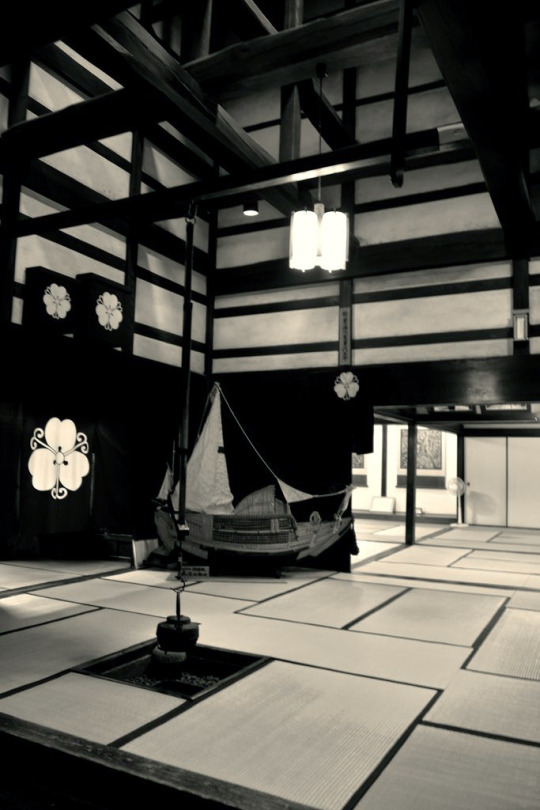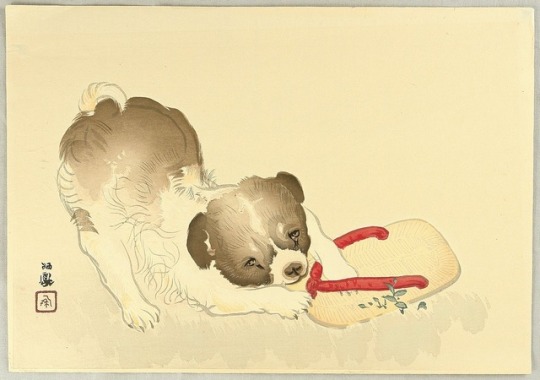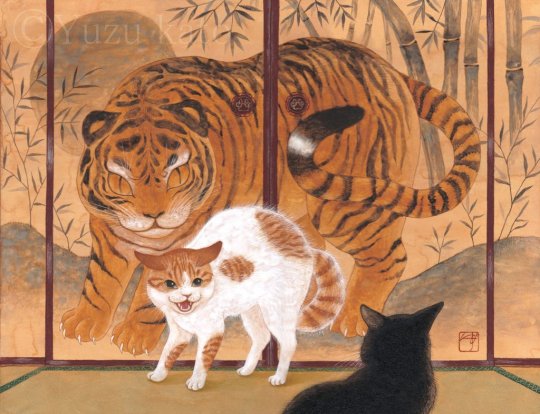Photo

Kakemono - “cat and Butterfly” de
Kansai Mori 寛斎森 (1814 - 1894).
1K notes
·
View notes
Text
IRL Japanese 2: Things the kids I teach say all the time
If you're planning to work as an ESL teacher in Japan working with kids, this vocab is gonna be super useful for you! You'll pick up a lot as you go along, but it's good to have an overview from the start.
できた = done, finished (whenever they finish an exercise I've set them. The older kids will use the ます-form, but kids under like age 8 will use this one)
かえる?= is it time to go home? (lit: go home?)
わかった = got it (again, the older kids will use the ます-form)
わからない / わかんない = I don't get it (idk if わかんない is just dialect or if it's common overall, but I hear it more than わからない. Usually from the kids who don't wanna be there and are making zero effort)
ちがう = wrong / different (when they give an answer but realise it's not correct. It's basically like "wait, no")
ばか = idiot (sometimes boys say this to their friends)
全部?(ぜんぶ)= everything?! (asked in disbelief when I ask them to write more than one word)
やめろ = stop it! (used with friends when they're teasing each other)
いたいよ = that actually hurts, you know! (used with friends when they're rough-housing)
よし (more like 'yoshhh') = right then (filler word indicating the start of an activity or a change of activity)
水筒(すいとう)= water bottle (most kids bring one to class and frequently forget to take them with them when they go home)
忘れた(わすれた)= I forgot (usually in reference to the text book they left at home)
トイレに行きたい = I want to go to the bathroom
先生、大好き!(せんせい、だいすき!)= I love you, Sensei!
Other useful classroom/school vocabulary:
サイコロ = dice
トランプ = playing cards
ごろごろ = onomatopeia for the sound for rolling (I found the kids got confused if I just mimed rolling a dice/ball and said "roll!" but if I did the gesture and said "gorogoro", they understood)
ビリビリ = onomatopeia for ripping (useful for when you have tear-apart crafts in class)
ケシケシ = onomatopeia for erasing something (useful when you try to explain to a kid they spelled something wrong. Because it's easier to just say "A kesh-kesh, E" than "Not A, E. Okay great you wrote E, but A needs to go. No no no not the whole word, just A. Oh my God. Okay. Let me write it and you copy.")
ちょっと = a little, soon, wait a little (useful if the kids are getting a bit antsy and ready to go home a bit too early/don't want to wait their turn. Don't use it with parents though!)
がんばれ = do your best / you can do it!
あぶない!= dangerous / look out! (useful if a kid unexpectedly runs in front of me while I'm carrying a table)
せえの!= Altogether now! (When I need the kids to repeat something after me)
だめだよ = Don't do that (for when the kids repeatedly do something I've asked them not to do)
少々お待ちください(しょうしょ�� おまち ください)= polite form of "please wait a moment". Useful if you have a parent talking to you and you need to go get something (e.g. a communication sheet for them to point at so you know what they're trying to say)
授業参観 (じゅぎょうさんかん) = parent observation (PO). A couple of times a year, parents are invited into the classroom to watch the lesson (absolutely not a thing in the UK, not sure about other countries). The past two months I've had POs at my various schools, and so the parents come to the door and ask me if it's PO week. I don't understand most of the question, but I can pick out this one word and a question particle and figure out what they're asking.
It's also obviously a good idea to learn vocabulary related to stationery (eraser, pencil, crayon, pen, notebook, textbook, pencil case etc) because kids forget/lose their stuff all the time and will inevitably ask you if they can borrow something.
505 notes
·
View notes
Photo

Moga in kimono with cat from Fujin gurafu 婦人グラフ (The Ladies graphic) - Photo by T. Yamanaka - Japan - February 1926
Source mandarake.co.jp
381 notes
·
View notes
Photo

Interior of traditional Japanese home built in 1878. The home has been designated by Japan as a national designated important cultural asset in December 27, 1994. Photography by Omi Genji on photohito
1K notes
·
View notes
Photo

Press photo for Repast (Meshi, めし), 1951, directed by Mikio Naruse (成瀬巳喜男) and starring Setsuko Hara (原節子) and Ken Uehara (上原謙).
1K notes
·
View notes
Photo

Puppy with favourite toy, by Takeuchi Seiho (ca. 1905)
934 notes
·
View notes
Photo

Terunobu Fujimori & Nobumichi Oshima, Teahouse Tetsu, 2006. Photo: Masuda Akihisa
5K notes
·
View notes
Text
16.01.24 四字熟語 (four-character idioms) containing 一

Answer and Translation
昔の日本人の食事は、ご飯と一汁一菜が基本でした。In the past, basic Japanese meals consisted of rice, broth, and a side dish.
一汁一菜(いちじゅういっさい)traditional one-plate meal (lit. "one broth one side-dish")
2. どのアイディアも一長一短で、なかなか決められません。Every idea has it's pros and cons, so it's hard to make a decision.
一長一短(いっちょういったん)advantages and disadvantages; pros and cons (lit. "one merit one fault")
映画監督は撮影の間、俳優の一挙一動を見ています。During filming, film directors are watching an actor's every move.
一挙一動(いっきょいちどう)one's every move/action; everything one does (lit. "one action one move")
お客様を迎えるときは*、いつも一期一会の気持ちが大切です。When welcoming customers, (providing) a once-in-a-lifetime experience is important.
一期一会(いちごいちえ)once-in-a-lifetime encounter; uniquely precious experience (lit. "one period one meeting")
* I believe there's a typo/an omission on the original page, so I've added ときは for "when"
30 notes
·
View notes
Text

Yuzu Kato
‘Borrowing from the Tiger’s Majesty’.
かとうゆず 「虎の威を借る」
78K notes
·
View notes
Photo


Photographer: Adolfo Farsari (Italian, 1841–1898)
Mukojima, Tokio
Ferry port on the Sumida River
1886?
457 notes
·
View notes
Photo

Photographer: Unidentified
Chion-in garden, Saikio
Meido, the main hall for the temple of the Jodo sect of Japanese Buddhism in Kyoto.
1880s
115 notes
·
View notes
Photo

A bronze model of an otter
Meiji era (1868-1912), late 19th century, Japan.
Cast as an otter holding a fish in its mouth, the animal’s fur rendered with fine lines and the fish highlighted with gilt, signed on the underside Toryuken. Bonhams.
2K notes
·
View notes
Photo

Crow and the Moon by Kawanabe Kyōsai, ca. 1887
2K notes
·
View notes



